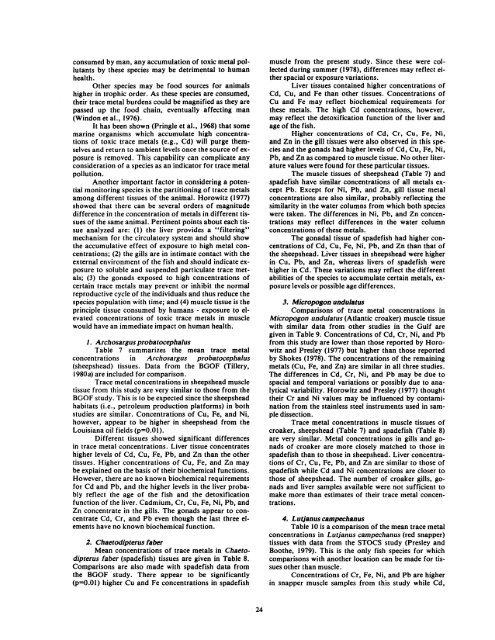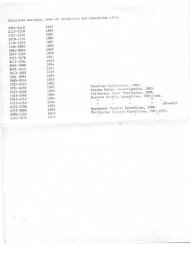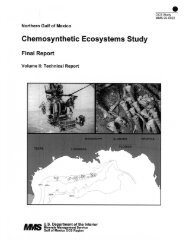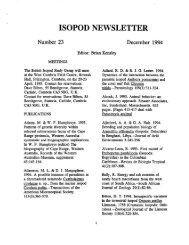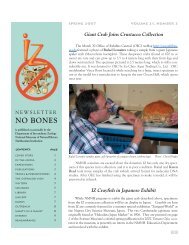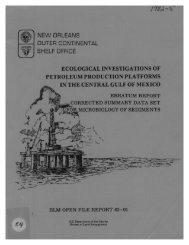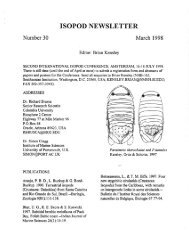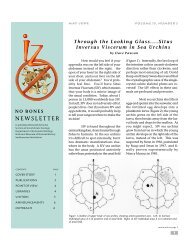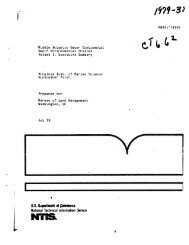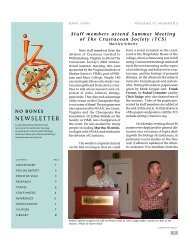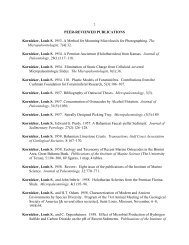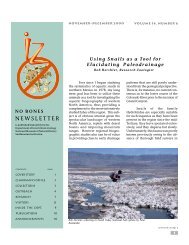Vol.1 part 4-5 - Department of Invertebrate Zoology
Vol.1 part 4-5 - Department of Invertebrate Zoology
Vol.1 part 4-5 - Department of Invertebrate Zoology
Create successful ePaper yourself
Turn your PDF publications into a flip-book with our unique Google optimized e-Paper software.
consumed by man, any accumulation <strong>of</strong> toxic metal pollutants<br />
by these species may be detrimental to human<br />
health .<br />
Other species may be food sources for animals<br />
higher in trophic order . As these species are consumed,<br />
their trace metal burdens could be magnified as they are<br />
passed up the food chain, eventually affecting man<br />
(Windon et al ., 1976) .<br />
It has been shown (Pringle et al ., 1968) that some<br />
marine organisms which accumulate high concentrations<br />
<strong>of</strong> toxic trace metals (e .g ., Cd) will purge themselves<br />
and return to ambient levels once the source <strong>of</strong> exposure<br />
is removed . This capability can complicate any<br />
consideration <strong>of</strong> a species as an indicator for trace metal<br />
pollution .<br />
Another important factor in considering a potential<br />
monitoring species is the <strong>part</strong>itioning <strong>of</strong> trace metals<br />
among different tissues <strong>of</strong> the animal . Horowitz (1977)<br />
showed that there can be several orders <strong>of</strong> magnitude<br />
difference in the concentration <strong>of</strong> metals in different tissues<br />
<strong>of</strong> the same animal . Pertinent points about each tissue<br />
analyzed are : (1) the liver provides a "filtering"<br />
mechanism for the circulatory system and should show<br />
the accumulative effect <strong>of</strong> exposure to high metal concentrations<br />
; (2) the gills are in intimate contact with the<br />
external environment <strong>of</strong> the fish and should indicate exposure<br />
to soluble and suspended <strong>part</strong>iculate trace metals<br />
; (3) the gonads exposed to high concentrations <strong>of</strong><br />
certain trace metals may prevent or inhibit the normal<br />
reproductive cycle <strong>of</strong> the individuals and thus reduce the<br />
species population with time ; and (4) muscle tissue is the<br />
principle tissue consumed by humans - exposure to elevated<br />
concentrations <strong>of</strong> toxic trace metals in muscle<br />
would have an immediate impact on human health .<br />
1 . Archosargus probatocephalus<br />
Table 7 summarizes the mean trace metal<br />
concentrations in Archosargus probatocephalus<br />
(sheepshead) tissues . Data from the BGOF (Tillery,<br />
1980a) are included for comparison .<br />
Trace metal concentrations in sheepshead muscle<br />
tissue from this study are very similar to those from the<br />
BGOF study . This is to be expected since the sheepshead<br />
habitats (i .e ., petroleum production platforms) in both<br />
studies are similar . Concentrations <strong>of</strong> Cu, Fe, and Ni,<br />
however, appear to be higher in sheepshead from the<br />
Louisiana oil fields (p=0.01) .<br />
Different tissues showed significant differences<br />
in trace metal concentrations . Liver tissue concentrates<br />
higher levels <strong>of</strong> Cd, Cu, Fe, Pb, and Zn than the other<br />
tissues . Higher concentrations <strong>of</strong> Cu, Fe, and Zn may<br />
be explained on the basis <strong>of</strong> their biochemical functions .<br />
However, there are no known biochemical requirements<br />
for Cd and Pb, and the higher levels in the liver probably<br />
reflect the age <strong>of</strong> the fish and the detoxification<br />
function <strong>of</strong> the liver . Cadmium, Cr, Cu, Fe, Ni, Pb, and<br />
Zn concentrate in the gills . The gonads appear to concentrate<br />
Cd, Cr, and Pb even though the last three elements<br />
have no known biochemical function.<br />
2. Chaetodipterus faber<br />
Mean concentrations <strong>of</strong> trace metals in Chaetodipterus<br />
faber (spadefish) tissues are given in Table 8 .<br />
Comparisons are also made with spadefish data from<br />
the BGOF study. There appear to be significantly<br />
(p=0 .01) higher Cu and Fe concentrations in spadefish<br />
muscle from the present study . Since these were collected<br />
during summer (1978), differences may reflect either<br />
spacial or exposure variations .<br />
Liver tissues contained higher concentrations <strong>of</strong><br />
Cd, Cu, and Fe than other tissues . Concentrations <strong>of</strong><br />
Cu and Fe may reflect biochemical requirements for<br />
these metals . The high Cd concentrations, however,<br />
may reflect the detoxification function <strong>of</strong> the liver and<br />
age <strong>of</strong> the fish .<br />
Higher concentrations <strong>of</strong> Cd, Cr, Cu, Fe, Ni,<br />
and Zn in the gill tissues were also observed in this species<br />
and the gonads had higher levels <strong>of</strong> Cd, Cu, Fe, Ni,<br />
Pb, and Zn as compared to muscle tissue . No other literature<br />
values were found for these <strong>part</strong>icular tissues .<br />
The muscle tissues <strong>of</strong> sheepshead (Table 7) and<br />
spadefish have similar concentrations <strong>of</strong> all metals except<br />
Pb . Except for Ni, Pb, and Zn, gill tissue metal<br />
concentrations are also similar, probably reflecting the<br />
similarity in the water columns from which both species<br />
were taken . The differences in Ni, Pb, and Zn concentrations<br />
may reflect differences in the water column<br />
concentrations <strong>of</strong> these metals .<br />
The gonadal tissue <strong>of</strong> spadefish had higher concentrations<br />
<strong>of</strong> Cd, Cu, Fe, Ni, Pb, and Zn than that <strong>of</strong><br />
the sheepshead . Liver tissues in sheepshead were higher<br />
in Cu, Pb, and Zn, whereas livers <strong>of</strong> spadefish were<br />
higher in Cd . These variations may reflect the different<br />
abilities <strong>of</strong> the species to accumulate certain metals, exposure<br />
levels or possible age differences .<br />
3. Micropogon undulates<br />
Comparisons <strong>of</strong> trace metal concentrations in<br />
Micropogon undulates (Atlantic croaker) muscle tissue<br />
with similar data from other studies in the Gulf are<br />
given in Table 9. Concentrations <strong>of</strong> Cd, Cr, Ni, and Pb<br />
from this study are lower than those reported by Horowitz<br />
and Presley (1977) but higher than those reported<br />
by Shokes (1978) . The concentrations <strong>of</strong> the remaining<br />
metals (Cu, Fe, and Zn) are similar in all three studies .<br />
The differences in Cd, Cr, Ni, and Pb may be due to<br />
spacial and temporal variations or possibly due to analytical<br />
variability. Horowitz and Presley (1977) thought<br />
their Cr and Ni values may be influenced by contamination<br />
from the stainless steel instruments used in sample<br />
dissection .<br />
Trace metal concentrations in muscle tissues <strong>of</strong><br />
croaker, sheepshead (Table 7) and spadefish (Table 8)<br />
are very similar . Metal concentrations in gills and gonads<br />
<strong>of</strong> croaker are more closely matched to those in<br />
spadefish than to those in sheepshead . Liver concentrations<br />
<strong>of</strong> Cr, Cu, Fe, Pb, and Zn are similar to those <strong>of</strong><br />
spadefish while Cd and Ni concentrations are closer to<br />
those <strong>of</strong> sheepshead . The number <strong>of</strong> croaker gills, gonads<br />
and liver samples available were not sufficient to<br />
make more than estimates <strong>of</strong> their trace metal ~concentrations<br />
.<br />
4. Lutjanus campechanus<br />
Table 10 is a comparison <strong>of</strong> the mean trace metal<br />
concentrations in Lutjanus campechanus (red snapper)<br />
tissues with data from the STOCS study (Presley and<br />
Boothe, 1979) . This is the only fish species for which<br />
comparisons with another location can be made for tissues<br />
other than muscle .<br />
Concentrations <strong>of</strong> Cr, Fe, Ni, and Pb are higher<br />
in snapper muscle samples from this study while Cd,<br />
24


